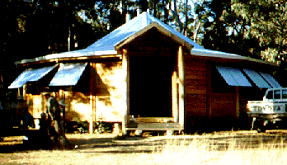

One of the cabins at the Saddler Springs Education Center.
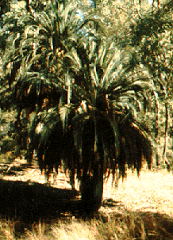
Division: Cycadophyta Class: Cycadopsida Order: Cycadales Family: Cycadaceae Species: Macrozamia moorei
In and around the Education Center, cycads such as Macrozamia moorei were common in the grassy understorey. This ancient plant is the symbol for the center. According to information from the Australian National Botanic Gardens, the Aboriginal peoples of Australia used this plant as a food source. "The seeds of these and other cycads are borne in a large cone and have an orange outer coat. They are poisonous, but the Aborigines knew how to treat them to remove the poison, and so take advantage of the large amount of food provided by a single plant. One of the ways was to cook the seed, break it up, and then soak it for up to three weeks in running water. In Western Australia, only the outer red part was eaten, after treatment by washing and burying."
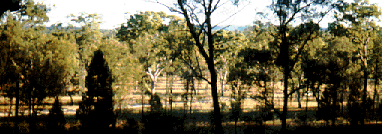
Much of the park area is open woodland on broad undulating hills. The Saddler Springs site (part of a working cattle station) is somewhat more rugged country with a combination of cliffs, gorges, spurs, and springs.
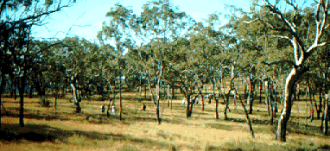
The late afternoon hike to Battleship Spur took us through the low bush country that is typically used for cattle grazing in this part of Australia.
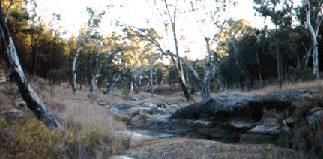
This was the program's only visit to an arid ecosystem, by far the most common in Australia. Here a creek bed is nearly dry after four months of no rain.
There was no electricity available. Students were not allowed to use radios, tape players, etc. while there. Water had to be hand pumped into a 4000 gallon storage tank and wood had to be split for cooking, campfires, and heating of water for showers. Students helped with meal preparation and clean-up. This trip was the least "formal" of the four. There were no data collection exercises and no computers. The emphasis was on experiential learning: getting to know the land by living with it.
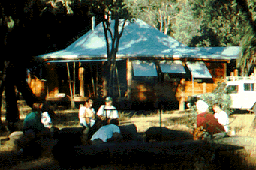
A warm shower and fire at the base camp provided welcome relief after the two day hike to Battleship Spur and back.
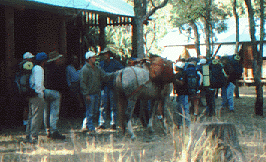
Packing up at the base camp at Saddler Springs in preparation for the hike to Battleship Spur.
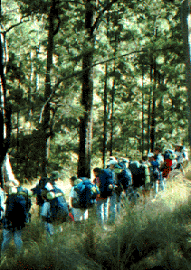
Hiking on the trail through low bush country.
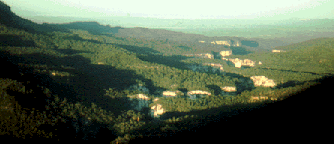
The Gorge in the late afternoon as seen from Battleship Spur.
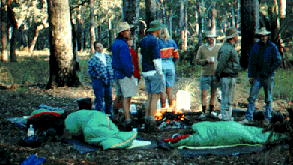
Breakfast was informal at the campsite.
2. A two day visit to the Mt. Moffat section of Carnarvon National Park.
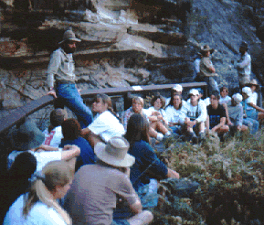
Here the emphasis was on the Aboriginal use of the land with an additional guided walk by Gavin Enevra of the Queensland National Park Service to "The Tombs".
The Tombs are a basaltic covered outcropping of sandstone. The basalt has protected the sandstone from weathering. For the Aborigines, this site had an important spiritual aspect serving as both an initiation and a burial site. It contains fine examples of Aboriginal stencil art done in red, yellow, and white ochres. This special ochre was carried more than 1000 miles by the Aborigines from a site in south Australia. This helped put our bush walk in perspective.
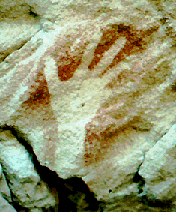
An example of the many red ochre stencils of hands seen at "The Tombs".
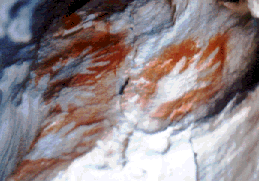
A left hand indicates that the individual has "received" something (often spiritual) at the site, while a right hand indicates that an offering has been made.

The design of this stenciled boomerang indicates that it was used for hunting.
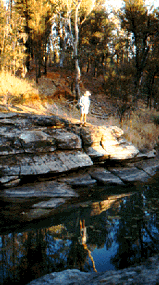
David Lowe '96 walks by the creek in the late afternoon sun near Dargonelly Rock Hole campsite.
3. The students got to know Lloyd Hancock (Director of Saddler Springs and a grazier) and his assistant Raymond Duffy (also a grazier) and their families very well. They obtained a glimpse of what it is like to live in the outback where children are educated by radio and the nearest town is 90 km of dirt road away.
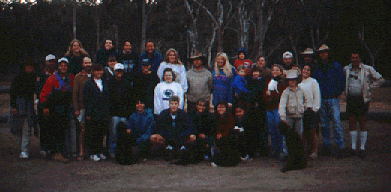
At Saddler Springs and Mt. Moffat, students were able to experience a part of Australia that even few Australians visit. The log book at the park shows that our group was only the second group to travel to Mt. Moffat by bus since this section of the park opened in 1988. We were the largest single group ever to visit the park. The park typically has a handful of visitors per week. An editor of the Queensland newspaper The Courier-Mail wrote about exactly this point.
But I will tell you more.... about the natural castles of Queensland which nature has painstakingly constructed over many thousands of years, the grand castles, fortresses and cathedrals of the Carnarvon Gorge.The thing that struck me walking into Carnarvon for the first time recently was what sort of dill was I to have ignored the place for almost 60 years when I've lived within a long day's drive of it most of my life.
But I am not alone in my ignorance of the Carnarvons because most Queenslanders have never been there, even many of those living on its doorstep in the Central Highlands.
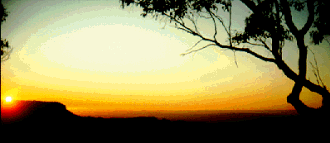
The gorge at sunset.
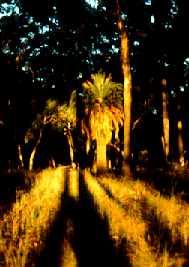
Division: Cycadophyta Class: Cycadopsida Order: Cycadales Family: Cycadaceae Species: Macrozamia moorei
The ancient Macrozamia, seen here in the early morning light, occupy the same ecological niche at Carnarvon as the grass trees, Xanthorrhoea johnsonii, do at Lamington and Stradbroke.